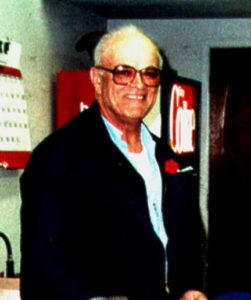
Herman Weisner, photo courtesy of his son, Craig Weisner
Herman B. Weisner died at his home in Williamsburg, New Mexico on January 13, 2003 following a long illness. He was 81.
He served his country in the U.S. Coast Guard, including during World War II in the Asiatic and Pacific theaters. He spent four years in Alaska, and the rest in the Pacific Theatre when the Coast Guard was placed under the Navy Department. A member of Disabled American Veterans and Veterans of Foreign Wars, he was interred in the Santa Fe National Cemetery.
Weisner was a soft-spoken gentleman, and a western – primarily of southern New Mexico – historian extraordinaire.
Herman had been a resident of Organ, New Mexico, near Las Cruces, for 35 years. Many of those years he worked as an electronics technician at the White Sands Missile Range. He was a writer of countless published factual articles of southwestern history and author of a book, The Politics of Justice: A.B. Fall and the Teapot Dome Scandal, A New Perspective.
After reading the manuscript that became that book in 1988, Hugh H. Milton II wrote him: “You know, Mr. Weisner, I was Under-Secretary of the Army in President Eisenhower’s administration. … Mr. Weisner, I have some knowledge of Albert Fall’s case. This manuscript on Albert Fall is one of the most interesting manuscripts I’ve read, and I’ve read many of them. I started reading it in the afternoon and did not put it down until I finished it after midnight.”
That man who commented on Herman’s research and writing of that book was, among other things over a period of more than 3 decades, president of New Mexico State University in Las Cruces and President of the New Mexico Military Institute in Roswell.
Leon C. Metz, western writer and historian, wrote in a letter in 1992 to a Mr. George Hicks in Walnut Cove, North Carolina, “I’ve known Herman [Weisner] for over 20 years, and have been proud to call him a friend and colleague. His research dealing with southern New Mexico has been nothing short of superb. Herman is what the late C. L. Sonnichsen would have called a Grass Roots Historian. He seeks out historical material wherever it might be found, and from it he draws perspectives that frequently change the historical world in which we live.”
Herman Weisner was a writer, but he was much more than that. More importantly, he was a doer … he personally went out and gathered the history himself instead of relying upon and repeating what others wrote. Many historians relied upon the information Weisner dug out of old dusty and moldy boxes and courthouses, using it in the books they subsequently wrote. The names of most of those historians probably became better known than his, but many of those writers of western history certainly knew his name and relied upon the integrity of his research.
Digging through those moldy documents harmed Herman’s lungs and overall health, and eventually he had to leave his beloved New Mexico. Several years ago, he and his wife, Augusta Kay, moved to the moister climate of Walnut Cove in North Carolina. However, because of his failing health, they returned to New Mexico, settling in Williamsburg in July 2001 to be closer to their grown children.
I first became acquainted with Weisner in the early 1990s when he came to Roswell to visit my mother and me. He had a theory and came seeking information because he heard my mother knew something about an Englishman named James Bonney. Karl Laumbach, anthropologist and New Mexico historian, brought Herman to see her in Roswell to find possible ties between Billy “The Kid” Bonney and James Bonney, a thought that had never before occurred to her.
As Bob Boze Bell wrote in his book, The Illustrated Life and Times of Billy the Kid, “Two-thirds of the Kid’s life is unknown. Legend and myth have filled in the gaps.”
According to that legend and myth, Billy was born to an Irish lass mother in a slum area of Manhattan in New York in 1859. That, however, is only speculation and no facts to substantiate that – place or date of birth – have ever been found. And there has never been a plausible reason why Billy adopted the name Bonney in the last years of his life.
James Bonney, a blue-eyed Englishman, settled in Missouri and there had a wife and family. One of his daughters was named Catherine. For several reasons, Weisner believed it possible that Catherine was the mother of Henry McCarty, alias William Henry Antrim, alias William H. Bonney. Among other things, on the 1880 census, the year before he died in July 1881, Billy claimed he was born in Missouri. Also, Catherine had relatives in Denver at a certain period of time as did James Bonney.
When the Santa Fe Trail opened, James’ wagon train traveled between Missouri and Santa Fe. He abandoned his Missouri family, established a trading post on the Santa Fe Trail at a place then called La Junta in northern New Mexico. There he began another family with another woman, the daughter of a Mora Land Grantee. They had three children. Later, he had a child, Ramon, with another young woman shortly before Indians killed him in October 1846. That young woman, named Bibiana Martin, the daughter of another Mora Land Grantee, was my great-great-grandmother. (She later had more children, one of whom became my great-grandmother.) In New Mexico are many descendents of James Bonney. Although I am not one, his story has long fascinated me.
Besides by his descendants, James Bonney was immortalized not long before he had died by travelers on the Trail, and by U.S. soldiers-journalists accompanying Gen. Stephen Watts Kearny and Gen. Alexander W. Doniphan in 1847 on their conquest of the West for the U.S.A. Those long-ago journalists wrote of the gentlemanly James Bonney, a handsome and charming man with blue eyes and red hair. Some of his own scholarly letters also survive him.
For several reasons, Herman Weisner believed that James Bonney was possibly Billy’s grandfather, and the source of his adopted name. However, because of his failing health, Herman was unable to fully prove his theory.
Over several decades, Herman made many discoveries. Among them was the handwritten court transcript of the trial of the man accused of the murder of Patrick Garrett, which had been lost for more than 100 years.
A few years ago, Herman Weisner donated a sizeable collection of research, photographs and other historical memorabilia to the New Mexico State University.
Without the tireless efforts of Herman Weisner, New Mexico might have missed some valuable pieces of history. And without the tireless efforts of his typist and beloved wife, Augusta Kay, we might have never known what we might have never known.

pink = emergency: severe drought
yellow = warning: moderate drought
blue = alert: mild drought
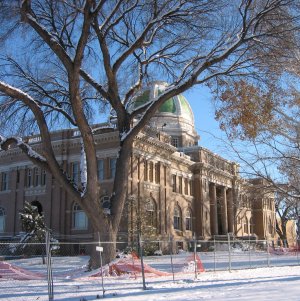
Chaves County Courthouse, photo taken December 23, 2002 from the northwest corner after first snowfall of the winter. This fine old building, completed the year New Mexico became a state in 1912, has begun to undergo historical restoration and considerable enlargement. In design and facade, the new will match the original part of the building, but the whole will be much more user-safe and user-friendly, extending its usefulness far into the new millennium.
Before the old jail was torn down to begin building the addition, the Historical Society for SENM took interior photos to preserve it for posterity in their archives. Some of those are herewith featured in this issue’s Focus Page.
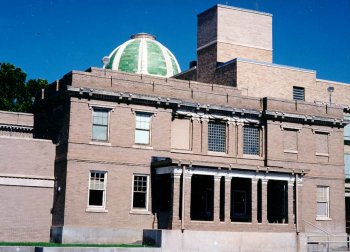
After the new Chaves County Detention Center was built and plans were announced that the old Chaves County jail would be razed, the Historical Society for Southeast New Mexico took steps to preserve the old jail in pictures. When inmates were “behind bars” in the old jail, they really were behind bars. Since such types of institutions of incarceration seem to be disappearing, the Society decided that pictures would be a way to preserve this unique type of historical artifact.
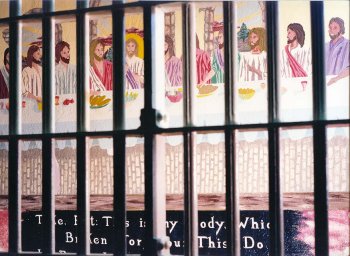
They secured a grant from the Historical Society of New Mexico and hired a professional photographer, d.d. cleveland, to take the pictures in July 1998. Through the assistance and cooperation of Mike Gallagher, administrator of the Juvenile Detention Center, some of the members of the Historical Society donned jail uniforms to add interest to the photos.
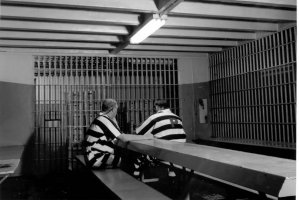
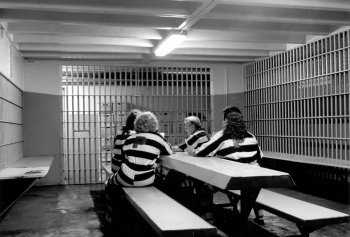
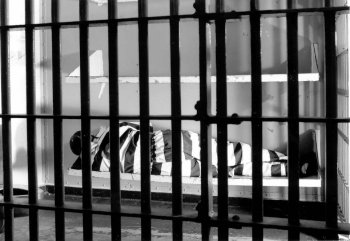
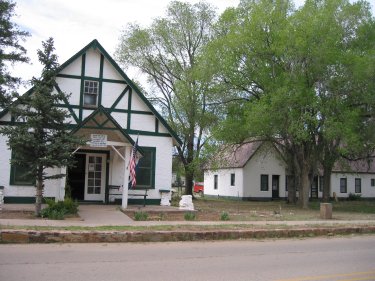
What people ask most often of us involved with Fort Stanton is, “What is the status of the fort right now?” Of course, there is no easy answer to that. What I will do with this particular article is to try to tell you where everything stands.
We have had the museum/visitors’ center open to the public since April 2001. During that time, we have had over 10,000 visitors from 48 states and 10 foreign countries. What makes this so significant is that Fort Stanton did not appear on any of the maps when we opened our doors. As it has been a corrections facility and was still being leased by the State Corrections Department, it had been removed from all maps. Our visitors were coming because they saw a rack card somewhere, or because of referrals by other museums and visitors centers, or by word-of-mouth. We have since been put on the byways maps and the State Highway Department has put up signs telling of the Fort Stanton Museum.
We then faced the challenge of the site signs, the ones that stood at the entrance of Fort Stanton and said “No admittance. Violators will be prosecuted.” Venturesome souls who still turned into the street were met by more signs in stronger language. We had our flags out. We had the welcome sign out. We stood in the doorway waving, but people turned around and left.
It took us six months of pestering the state government to get the signs moved further back, beyond the museum. Through the sale of books, shirts, mugs, notes and prints we have a bank account. It is not extravagant but it keeps our bills paid. We are no longer dependent on one of our board members to come up with money when we need it.
Through the donations of our “friends,” we have started restoration on the 1916 American La France fire truck that belonged to Fort Stanton. The Pine Top Car Club has been doing the physical work and tracking down the parts needed to bring this lovely piece of machinery back to its original condition. Once it’s in running order, we will loan her out for performances in parades, village, town and city functions. We hope the exposure to her and our cause will encourage more “friends” to make themselves known and join forces with us.
Last May, we hosted Fort Stanton LIVE! — a one day celebration in honor of National Historical Preservation Week. It was a day filled with food, fun, living history, reenactments, music, book signings, old time crafters and A CHANCE FOR THE PUBLIC TO HAVE ACCESS TO THE QUADRANGLE! It exceeded our expectations.
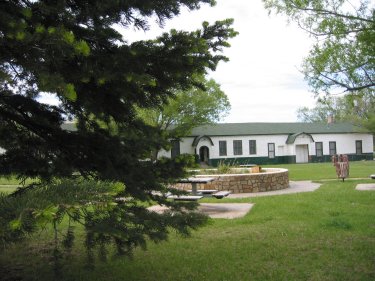
Plans are already in the works for next year’s event. It will be an even bigger and better event than before. To be held in August in conjunction with a Civil War reenactment, we will offer you a chance to see battles, tour the Fort Stanton cave, and hear the stories of the men and women who lived, worked and did business with the fort. Join a sing-along of military camp songs, sea chanteys and German Beer Garden songs — songs representing all the different people who inhabited the fort over the years.
Through a grant from the Hubbard Foundation, we have acquired a complete computer center with copier, fax, printer and scanner that has enabled us to have all of the museum items catalogued. We are in process of updating all of our “friends” records and the start of an archive. This has been an invaluable asset as we are an organization completely composed of volunteers. B.C. (before computer), our records were being kept by nearly all of us. Whoever was at the museum any given day kept track of who left us donations and did the necessary paperwork. People fell through the cracks; we are now trying to reconstruct the “friends” lists. We have upgraded our newsletter and have just mailed out the fall, 2002 edition. David Clarke, a member of our board, is undertaking the task of updating and expanding our website. Eventually it will include a virtual tour of the fort.
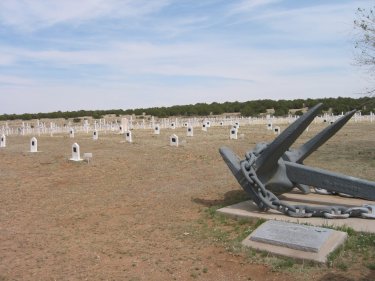
Just before the 9-11-01 crisis, the FCC advertised 100-watt radio stations available to 501C-3 Corporations like us. As one of our board members, Dick Weber, had some expertise in this area, Fort Stanton, Inc. applied for a station. Then the crisis hit and everything within the government virtually shut down. On October 12, 2002, we were notified that our license was granted. There was a standard 30-day waiting period that allowed anyone to protest the license; ours began October 15 and ended November 15 without a filing.
Fort Stanton, Inc. will be the owner/operator of station KEDU, 102.3 FM on your dial. The goal of the station is to provide entertainment in the form of music of all types, educational information about area attractions, public service announcements from area organizations and clubs and emergency messages from authorities involved in community safety.
This station is a major undertaking for us, and is completely committed to the community. Fort Stanton, Inc. so believed in this commitment that we put up money to apply for the license. But it is an undertaking that we cannot complete by ourselves. We will ask groups, businesses and individuals for the funds to make this station a reality. It will be interesting to see how many people believe as we do and who will step up when needed.
One of the primary functions of this station will be its emergency abilities. Currently we do not have a station that broadcasts fire news continuously when we have a fire danger. Station KEDU can do that. Currently we do not have a station that broadcasts organization news on a regular basis. KEDU can do that. Currently we do not have a station that broadcasts an events calendar. Station KEDU can do that. Currently we do not have a station that makes bilingual broadcasts, that broadcasts all emergency events, regulations and things of major importance in Apache, Spanish, English and, in the summer, Texican. Station KEDU can do that. Currently we do not have a station with the variety to entertain all listeners, from the very young to the very young at heart. Station KEDU can do that. Currently we do not have a station that offers public service announcements on everything from organizations to garage sales to business openings to job calendars to things you can’t find anywhere else. Station KEDU can do that. Currently we do not have a station that offers “job training” in the communications field. Station KEDU can do that. Station KEDU can be the soul of Ruidoso, bringing locals together with the visiting population through communication of everything and everyone that matters in our little corner of the world. We have one year to make it happen. WE ARE ABOUT TO EXPERIENCE WHAT COMMUNITY SPIRIT IS ALL ABOUT.
That is only what we are doing on the local scene. We are preparing grant proposals for a walking tour book for the fort grounds. We are preparing our latest onslaught against the powers that be in Santa Fe for the protection and preservation of Fort Stanton, for its rehabilitation as a living history park, and for its becoming fully open to the public as soon as possible.
* Maintains joint mobility;
* Supports cartilage growth;
* Promotes joint lubrication; and
* Encourages production of synovial fluid.
BioChoice FLEX contains the highest quality of glucosamine on the market. Glucosamine is a naturally occurring substance in the body that plays a significant role in cartilage formation and repair. Shellfish is the source of glucosamine in BioChoice FLEX.
Email jan@themail.us or call 505-623-0640 to order yours today.
 Roswell Web Magazine
Roswell Web Magazine